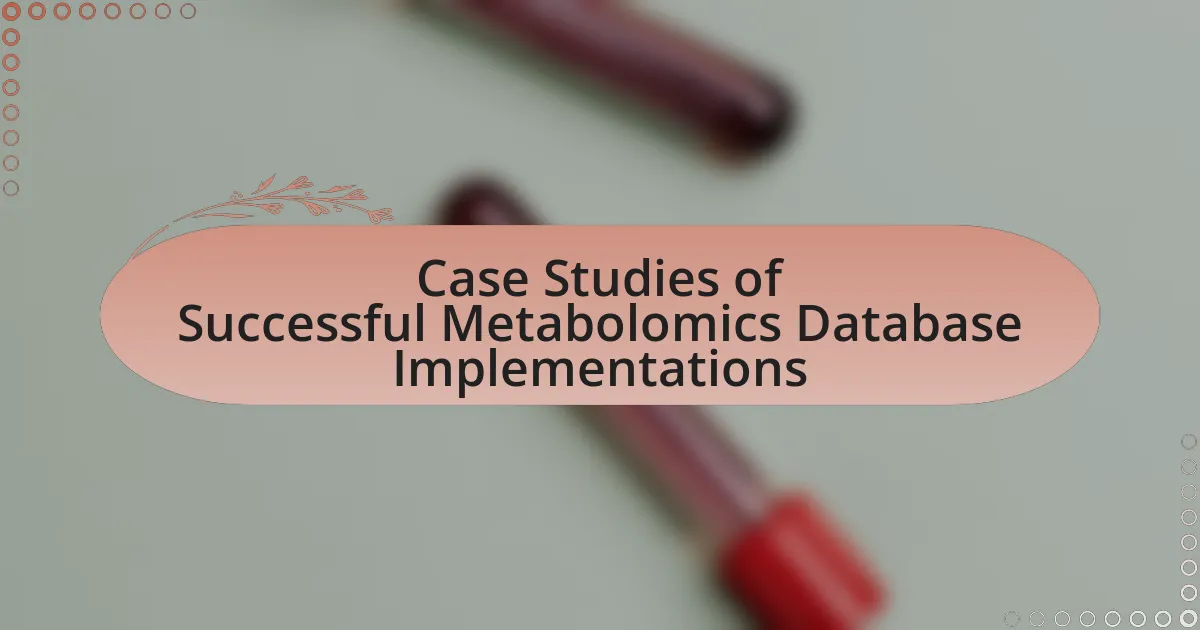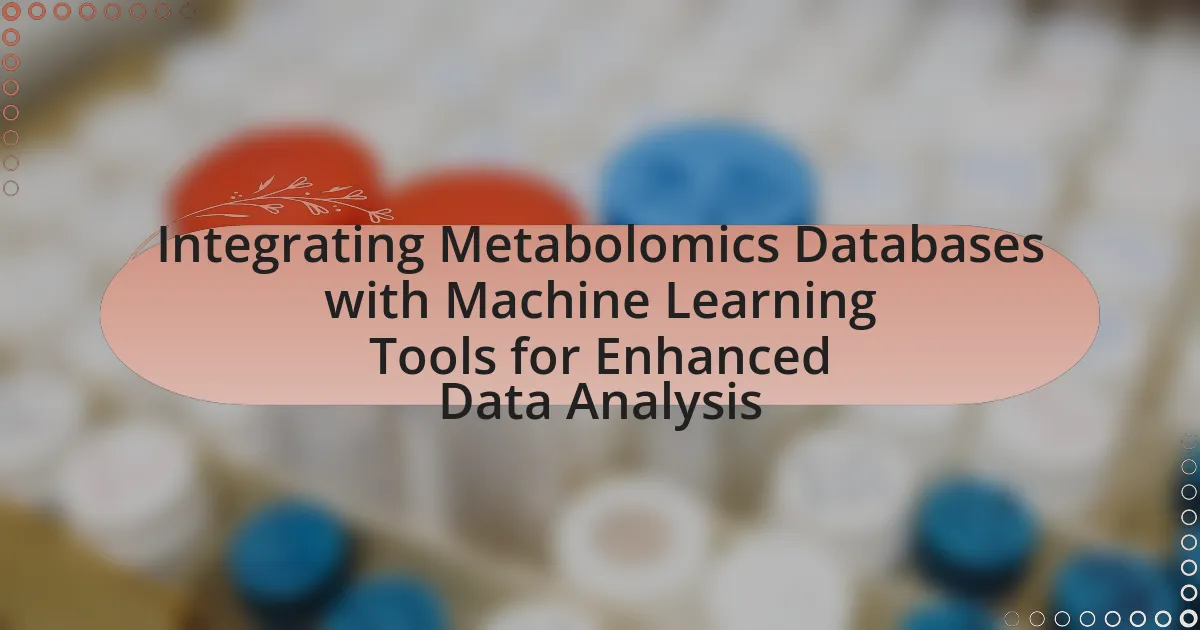Metabolomics is the comprehensive study of metabolites within biological systems, playing a crucial role in biomarker discovery by identifying specific metabolites that indicate disease states and physiological conditions. This article explores how metabolomics enhances the understanding of biological processes, the key techniques employed such as mass spectrometry and nuclear magnetic resonance spectroscopy, and the importance of these methods in diagnosing diseases like cancer and diabetes. Additionally, it addresses the challenges and limitations faced in metabolomics research, strategies to overcome these obstacles, and the future directions of the field, emphasizing the integration of advanced technologies and collaborative approaches to improve biomarker identification and validation.
What is Metabolomics and its Role in Biomarker Discovery?
Metabolomics is the comprehensive study of metabolites in biological systems, providing insights into metabolic processes and pathways. Its role in biomarker discovery is significant, as it enables the identification of specific metabolites that can serve as indicators of disease states, physiological conditions, or responses to treatments. For instance, research has shown that altered metabolite profiles can be linked to various diseases, such as cancer and diabetes, making metabolomics a powerful tool in the early detection and diagnosis of these conditions. By analyzing metabolic changes, scientists can uncover potential biomarkers that facilitate personalized medicine and improve patient outcomes.
How does metabolomics contribute to understanding biological processes?
Metabolomics contributes to understanding biological processes by providing comprehensive insights into the metabolic profiles of organisms. This field analyzes small molecules, or metabolites, which reflect the physiological state of cells and tissues, thereby revealing the biochemical pathways and networks involved in various biological functions. For instance, studies have shown that metabolomic analyses can identify specific metabolic changes associated with diseases, such as cancer or diabetes, enabling researchers to understand disease mechanisms and identify potential biomarkers for diagnosis and treatment.
What are the key techniques used in metabolomics?
The key techniques used in metabolomics include mass spectrometry (MS), nuclear magnetic resonance (NMR) spectroscopy, and chromatography. Mass spectrometry is widely utilized for its sensitivity and ability to analyze complex mixtures, allowing for the identification and quantification of metabolites. Nuclear magnetic resonance spectroscopy provides structural information about metabolites and is valuable for non-destructive analysis. Chromatography techniques, such as gas chromatography (GC) and liquid chromatography (LC), are essential for separating metabolites before analysis, enhancing the accuracy of the results. These techniques collectively enable comprehensive profiling of metabolic changes, which is crucial for biomarker discovery in various diseases.
How do these techniques facilitate biomarker discovery?
Metabolomics techniques facilitate biomarker discovery by enabling the comprehensive analysis of metabolites in biological samples, which can reveal disease-specific metabolic profiles. These techniques, such as mass spectrometry and nuclear magnetic resonance spectroscopy, allow for the identification and quantification of small molecules that serve as indicators of physiological or pathological states. For instance, studies have shown that specific metabolite alterations can correlate with conditions like cancer or diabetes, providing a basis for developing diagnostic biomarkers.
Why is metabolomics important in the context of disease?
Metabolomics is important in the context of disease because it enables the comprehensive analysis of metabolites, which are small molecules involved in metabolic processes. This analysis provides insights into disease mechanisms, facilitates early diagnosis, and aids in the identification of potential biomarkers for various conditions. For instance, studies have shown that specific metabolomic profiles can differentiate between healthy individuals and those with diseases such as cancer or diabetes, thereby enhancing diagnostic accuracy and personalized treatment approaches.
What types of diseases can be studied through metabolomics?
Metabolomics can be used to study a variety of diseases, including cancer, cardiovascular diseases, diabetes, neurological disorders, and metabolic syndromes. Research has shown that metabolomics provides insights into the biochemical changes associated with these diseases, enabling the identification of potential biomarkers for diagnosis and treatment. For instance, studies have demonstrated that specific metabolite profiles can differentiate between cancer types, aiding in early detection and personalized therapy.
How does metabolomics enhance disease diagnosis and treatment?
Metabolomics enhances disease diagnosis and treatment by providing a comprehensive analysis of metabolites in biological samples, which can reveal disease-specific biomarkers. This approach allows for the identification of metabolic changes associated with various diseases, enabling earlier diagnosis and more personalized treatment strategies. For instance, studies have shown that metabolomic profiling can differentiate between cancer types and stages, leading to targeted therapies that improve patient outcomes. Additionally, the integration of metabolomics with other omics technologies has been demonstrated to enhance the understanding of disease mechanisms, further refining diagnostic and therapeutic approaches.
What are the challenges in metabolomics for biomarker discovery?
The challenges in metabolomics for biomarker discovery include the complexity of biological samples, variability in metabolite concentrations, and the need for standardized methodologies. Biological samples, such as blood or urine, contain thousands of metabolites, making it difficult to identify specific biomarkers amidst this complexity. Variability arises from factors like diet, genetics, and environmental influences, which can affect metabolite levels and lead to inconsistent results. Additionally, the lack of standardized protocols for sample collection, processing, and analysis can result in reproducibility issues, hindering the validation of potential biomarkers. These challenges necessitate advanced analytical techniques and robust statistical methods to ensure reliable biomarker discovery in metabolomics.
What limitations exist in current metabolomics methodologies?
Current metabolomics methodologies face several limitations, including issues with sensitivity, specificity, and reproducibility. Sensitivity limitations arise from the difficulty in detecting low-abundance metabolites, which can lead to incomplete metabolic profiling. Specificity challenges occur due to the overlap in mass spectra of different metabolites, complicating accurate identification. Additionally, reproducibility is often hindered by variations in sample preparation, instrument calibration, and data analysis techniques, which can result in inconsistent results across studies. These limitations impact the reliability of metabolomics in biomarker discovery, as highlighted in research by Wishart et al. (2018) in “Metabolomics: A Powerful Tool for Biomarker Discovery” published in Nature Reviews.
How do these limitations affect biomarker validation?
Limitations in metabolomics, such as variability in sample collection, analytical techniques, and data interpretation, significantly hinder biomarker validation. These factors can lead to inconsistent results, making it difficult to establish reliable biomarkers for disease diagnosis or prognosis. For instance, variations in sample handling can introduce pre-analytical biases, while differences in analytical methods can affect the reproducibility of metabolite measurements. Consequently, these inconsistencies can result in false positives or negatives, undermining the credibility of potential biomarkers and delaying their clinical application.
What strategies can be employed to overcome these challenges?
To overcome challenges in metabolomics and its role in biomarker discovery, researchers can employ strategies such as standardization of protocols, integration of multi-omics data, and utilization of advanced analytical techniques. Standardization of protocols ensures consistency in sample collection, processing, and analysis, which is crucial for reproducibility and comparability of results. Integration of multi-omics data, including genomics and proteomics, enhances the understanding of biological systems and improves the identification of potential biomarkers. Advanced analytical techniques, such as mass spectrometry and nuclear magnetic resonance, provide high sensitivity and specificity, enabling the detection of low-abundance metabolites that may serve as biomarkers. These strategies collectively address the complexities and variability inherent in metabolomics research, facilitating more reliable biomarker discovery.
How does data analysis play a role in metabolomics?
Data analysis is crucial in metabolomics as it enables the interpretation and integration of complex metabolic data to identify biomarkers. Through techniques such as statistical analysis, machine learning, and data mining, researchers can discern patterns and correlations within large datasets generated by metabolomic studies. For instance, advanced algorithms can process data from mass spectrometry and nuclear magnetic resonance spectroscopy, facilitating the identification of metabolites that are significantly altered in disease states. This analytical approach has been validated in studies, such as those published in “Nature Reviews Molecular Cell Biology,” which demonstrate how data analysis leads to the discovery of potential biomarkers for conditions like cancer and diabetes.
What are the common data analysis techniques used in metabolomics?
Common data analysis techniques used in metabolomics include statistical analysis, multivariate analysis, and machine learning. Statistical analysis, such as t-tests and ANOVA, helps identify significant differences between groups. Multivariate analysis techniques, like principal component analysis (PCA) and partial least squares discriminant analysis (PLS-DA), are employed to reduce dimensionality and visualize complex data sets. Machine learning algorithms, including support vector machines and random forests, are increasingly utilized for classification and prediction tasks in metabolomics. These techniques collectively enhance the interpretation of metabolic profiles and facilitate biomarker discovery by identifying patterns and correlations within the data.
How do these techniques impact the identification of biomarkers?
Metabolomics techniques significantly enhance the identification of biomarkers by providing comprehensive profiles of metabolites in biological samples. These techniques, such as mass spectrometry and nuclear magnetic resonance spectroscopy, enable the detection of small molecules that reflect physiological changes, disease states, or responses to treatment. For instance, a study published in “Nature Reviews Drug Discovery” by Wishart et al. (2018) demonstrated that metabolomics can identify unique metabolic signatures associated with various diseases, thereby facilitating early diagnosis and personalized medicine approaches. This capability to analyze complex biological data allows researchers to pinpoint specific metabolites that serve as reliable biomarkers, ultimately improving disease management and therapeutic strategies.
What are the future directions of metabolomics in biomarker discovery?
Future directions of metabolomics in biomarker discovery include the integration of advanced analytical techniques, such as mass spectrometry and nuclear magnetic resonance, with machine learning algorithms to enhance data interpretation and biomarker identification. This integration aims to improve the sensitivity and specificity of biomarkers for various diseases, including cancer and metabolic disorders. Additionally, the focus is shifting towards personalized medicine, where metabolomics can provide insights into individual metabolic profiles, leading to tailored therapeutic strategies. Research is also emphasizing the importance of longitudinal studies to understand metabolic changes over time, which can aid in early disease detection and monitoring. These advancements are supported by increasing collaborations between academic institutions and industry, fostering innovation in metabolomics applications.
How is technology evolving to support metabolomics research?
Technology is evolving to support metabolomics research through advancements in analytical techniques, data processing, and integration with other omics disciplines. High-resolution mass spectrometry and nuclear magnetic resonance spectroscopy have significantly improved the sensitivity and accuracy of metabolite detection, enabling researchers to identify a broader range of metabolites in biological samples. Additionally, the development of software tools for data analysis, such as machine learning algorithms, facilitates the interpretation of complex datasets, allowing for more efficient biomarker discovery. Furthermore, the integration of metabolomics with genomics and proteomics enhances the understanding of metabolic pathways and their roles in disease, providing a more comprehensive view of biological systems.
What emerging technologies show promise for enhancing metabolomics?
Emerging technologies that show promise for enhancing metabolomics include mass spectrometry (MS), nuclear magnetic resonance (NMR) spectroscopy, and high-resolution liquid chromatography. Mass spectrometry, particularly in its latest forms such as tandem mass spectrometry (MS/MS), allows for the rapid and sensitive detection of metabolites, enabling the analysis of complex biological samples with high specificity. Nuclear magnetic resonance spectroscopy provides detailed structural information about metabolites, facilitating the identification of unknown compounds. High-resolution liquid chromatography enhances the separation of metabolites, improving the overall sensitivity and accuracy of metabolomic analyses. These technologies collectively contribute to more comprehensive and precise metabolomic profiling, which is essential for biomarker discovery and understanding metabolic pathways.
How might these technologies improve biomarker discovery processes?
Technologies such as mass spectrometry and nuclear magnetic resonance spectroscopy significantly enhance biomarker discovery processes by enabling the detailed analysis of metabolites in biological samples. These advanced analytical techniques provide high sensitivity and specificity, allowing researchers to identify and quantify a wide range of metabolites that may serve as potential biomarkers for diseases. For instance, a study published in “Nature Reviews Drug Discovery” by Wishart et al. (2018) highlights how metabolomics can uncover metabolic alterations associated with various diseases, facilitating early diagnosis and personalized treatment strategies. This capability to detect subtle metabolic changes is crucial for developing effective biomarkers, ultimately improving patient outcomes.
What best practices should researchers follow in metabolomics studies?
Researchers in metabolomics studies should adhere to best practices that include standardization of sample collection, rigorous quality control, and comprehensive data analysis. Standardization ensures consistency across samples, which is critical for reproducibility; for instance, using the same protocols for sample handling and storage can minimize variability. Rigorous quality control measures, such as the use of internal standards and blanks, help identify and mitigate potential sources of error in the analytical process. Comprehensive data analysis involves employing robust statistical methods to interpret complex datasets, which is essential for identifying meaningful metabolic changes associated with biological conditions. These practices are supported by guidelines from organizations like the Metabolomics Society, which emphasize the importance of these steps in achieving reliable and reproducible results in metabolomics research.
How can researchers ensure the reliability of their metabolomics data?
Researchers can ensure the reliability of their metabolomics data by implementing rigorous experimental design, standardization of protocols, and validation of analytical methods. Rigorous experimental design includes using appropriate controls and replicates to minimize variability. Standardization of protocols ensures consistency in sample collection, processing, and analysis, which is crucial for reproducibility. Validation of analytical methods, such as mass spectrometry and nuclear magnetic resonance, involves assessing parameters like sensitivity, specificity, and accuracy to confirm that the methods produce reliable results. Studies have shown that following these practices significantly enhances data quality and reproducibility in metabolomics research.
What collaborative approaches can enhance metabolomics research outcomes?
Collaborative approaches that can enhance metabolomics research outcomes include interdisciplinary partnerships, data sharing initiatives, and integration of diverse expertise. Interdisciplinary partnerships, such as collaborations between chemists, biologists, and bioinformaticians, facilitate comprehensive analysis and interpretation of metabolomic data, leading to more robust findings. Data sharing initiatives, like the Metabolomics Workbench, allow researchers to access and contribute to a centralized repository of metabolomic data, promoting reproducibility and validation of results. Furthermore, integrating expertise from clinical researchers and epidemiologists can enhance the relevance of metabolomics in biomarker discovery, ensuring that findings are applicable to real-world health scenarios. These collaborative strategies have been shown to improve the quality and impact of metabolomics research, as evidenced by increased publication rates and citation metrics in studies that leverage such partnerships.











